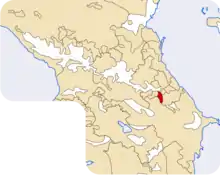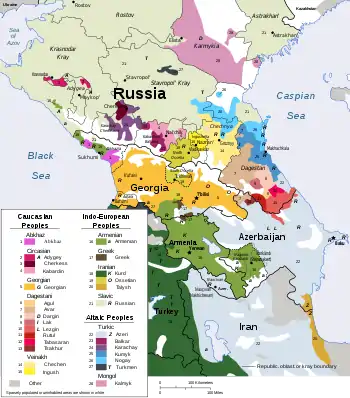Rutul language
Rutul is a language spoken by the Rutuls, an ethnic group living in Dagestan (Russia) and some parts of Azerbaijan. It is spoken by 30,000 people in Dagestan (2010 census)[3] and 17,000 (no date) in Azerbaijan.[4] The word Rutul derives from the name of a Dagestani village where speakers of this language make up the majority.[5]
| Rutul | |
|---|---|
| мыхӀабишды чӀел myxʼabišdy č̣el | |
| Pronunciation | [mɨxabiʃdɨ t͡ʃʼɛl] |
| Native to | North Caucasus, Azerbaijan |
| Region | Southern Dagestan, Russian–Azerbaijani border |
| Ethnicity | Rutul |
Native speakers | 36,400 (2010 census)[1] |
| Cyrillic | |
| Official status | |
Official language in | |
| Language codes | |
| ISO 639-3 | rut |
| Glottolog | rutu1240 |
| ELP | Rutul[2] |
 Rutul in the Caucasus | |
Rutul is endangered in Russia[6] and classified as "definitely endangered" by UNESCO's Atlas of the World's Languages in Danger.[7]
Classification
Rutul belongs to the Lezgic group of the Northeast Caucasian language family. The Rutuls call their language myxʼabišdy čʼel.
History
Rutul was not a written language until the writing system for it (based on Cyrillic) was developed in 1990. A Latin alphabet was developed in 2013 based on the Shin-Shorsu dialect.[8] Speakers are often bilingual or multilingual, having a good command of the Azeri, Lezgian and/or Russian languages. There are 8 dialects and 2 subdialects of Rutul. The literary version of the language remains in the process of development. In the Rutul-populated regions of southern Russia, Rutul is taught in primary schools (grades 1 to 4).[5]
Phonology
Consonants
| Labial | Dental | Alveolar | Palatal | Velar | Uvular | Pharyn- geal |
Glottal | ||||||
|---|---|---|---|---|---|---|---|---|---|---|---|---|---|
| plain | lab. | plain | lab. | plain | lab. | plain | lab. | ||||||
| Nasal | m | n | |||||||||||
| Plosive | voiced | b | d | ɡ | ɡʷ | ɢ | ɢʷ | ||||||
| voiceless | p | t | k | kʷ | q | qʷ | ʡ | ʔ | |||||
| ejective | pʼ | tʼ | kʼ | kʷʼ | qʼ | qʷʼ | |||||||
| Affricate | voiced | d͡z | d͡ʒ | d͡ʒʷ | |||||||||
| voiceless | t͡s | t͡sʷ | t͡ʃ | t͡ʃʷ | |||||||||
| ejective | t͡sʼ | t͡sʷʼ | t͡ʃʼ | t͡ʃʷʼ | |||||||||
| Fricative | voiceless | (f) | s | sʷ | ʃ | ʃʷ | x | xʷ | χ | χʷ | ħ | h | |
| voiced | z | (ʒ) | ɣ | ʁ | ʁʷ | ʢ | |||||||
| Trill | r | ʜ | |||||||||||
| Approximant | w | l | j | ||||||||||
Related languages
Among the languages of the Lezgic group, Tsakhur appears to be the closest relative of Rutul.[10] Other than these two, there are seven more languages in the Lezgic group, namely: Lezgian, Tabasaran, Aghul, Budukh, Kryts, Udi and Archi.

References
- "Rutul". Ethnologue. Retrieved 2018-07-31.
- Endangered Languages Project data for Rutul.
- Информационные материалы об окончательных итогах Всероссийской переписи населения 2010 года
- Rutul language at Ethnologue (17th ed., 2013)
- (in Russian) ETHEO: Rutul Language
- Published in: Encyclopedia of the world’s endangered languages. Edited by Christopher Moseley. London & New York: Routledge, 2007. 211–280.
- UNESCO Interactive Atlas of the World’s Languages in Danger
- Clarkson, Jonathan; Iurkova, Elena (December 2015). "Important Factors in the Development of an Orthography: Shin-Shorsu Rutul—a Case Study". SIL Forum for Language Fieldwork 2015-002. SIL International. Archived from the original (PDF) on 2015. Retrieved 2016-06-22.
- G. X. Ibragimov. 2004. Rutul'skij Jazyk. Machacala: Maxačkala: Dagestanskij Gosudarstvennyj Pedagogičeskij Universitet.
- (in Russian) The Tsakhur language. The ETHEO Project. Last updated 11 October 2005. Retrieved 26 December 2006
External links
| Rutul language test of Wikipedia at Wikimedia Incubator |
- Rutul dictionary online (select simple or advanced browsing)
- Appendix:Cyrillic script
- Folk Songs and Dances of the Rutuls of Azerbaijan
- Rutul basic lexicon at the Global Lexicostatistical Database (3 Rutul dialects: Mukhad, Ixrek, Luchek)
